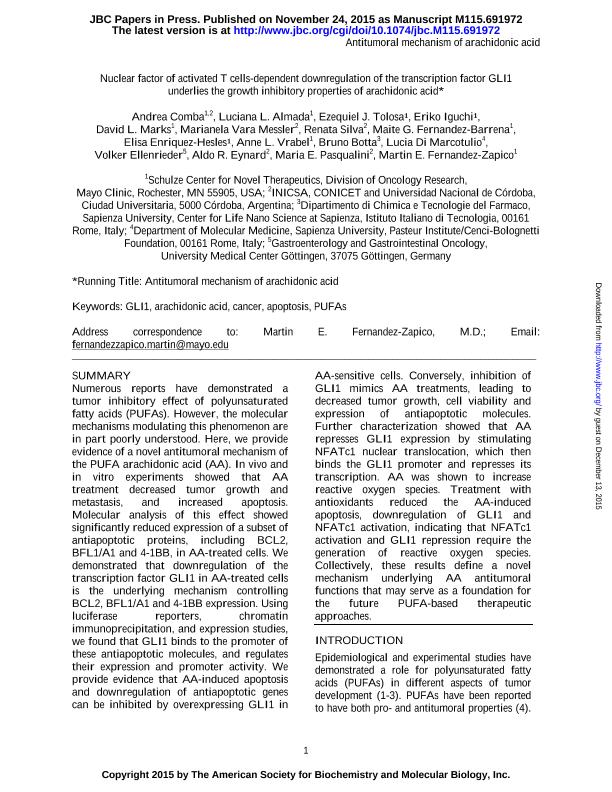Artículo
Nuclear factor of activated T cells-dependent downregulation of the transcription factor glioma-associated protein 1 (GLI1) underlies the growth inhibitory properties of arachidonic acid
Comba, Andrea ; Almada, Luciana Victoria; Tolosa, Ezequiel J.; Iguchi, Eriko; Marks, David L.; Vara Messler, Marianela
; Almada, Luciana Victoria; Tolosa, Ezequiel J.; Iguchi, Eriko; Marks, David L.; Vara Messler, Marianela ; Silva, Renata Alejandra; Fernandez-Barrena, Maite G.; Enriquez-Hesles, Elisa; Vrabel, Anne L.; Botta, Bruno; Di Marcotulio, Lucia; Ellenrieder, Volker; Eynard, Aldo Renato
; Silva, Renata Alejandra; Fernandez-Barrena, Maite G.; Enriquez-Hesles, Elisa; Vrabel, Anne L.; Botta, Bruno; Di Marcotulio, Lucia; Ellenrieder, Volker; Eynard, Aldo Renato ; Pasqualini, María Eugenia; Fernandez Zapico, Martin Ernesto
; Pasqualini, María Eugenia; Fernandez Zapico, Martin Ernesto
 ; Almada, Luciana Victoria; Tolosa, Ezequiel J.; Iguchi, Eriko; Marks, David L.; Vara Messler, Marianela
; Almada, Luciana Victoria; Tolosa, Ezequiel J.; Iguchi, Eriko; Marks, David L.; Vara Messler, Marianela ; Silva, Renata Alejandra; Fernandez-Barrena, Maite G.; Enriquez-Hesles, Elisa; Vrabel, Anne L.; Botta, Bruno; Di Marcotulio, Lucia; Ellenrieder, Volker; Eynard, Aldo Renato
; Silva, Renata Alejandra; Fernandez-Barrena, Maite G.; Enriquez-Hesles, Elisa; Vrabel, Anne L.; Botta, Bruno; Di Marcotulio, Lucia; Ellenrieder, Volker; Eynard, Aldo Renato ; Pasqualini, María Eugenia; Fernandez Zapico, Martin Ernesto
; Pasqualini, María Eugenia; Fernandez Zapico, Martin Ernesto
Fecha de publicación:
01/2016
Editorial:
American Society for Biochemistry and Molecular Biology
Revista:
Journal of Biological Chemistry (online)
ISSN:
0021-9258
e-ISSN:
1083-351X
Idioma:
Inglés
Tipo de recurso:
Artículo publicado
Clasificación temática:
Resumen
Numerous reports have demonstrated a tumor inhibitory effect of polyunsaturated fatty acids (PUFAs). However, the molecular mechanisms modulating this phenomenon are in part poorly understood. Here, we provide evidence of a novel antitumoral mechanism of the PUFA arachidonic acid (AA). In vivo and in vitro experiments showed that AA treatment decreased tumor growth and metastasis and increased apoptosis. Molecular analysis of this effect showed significantly reduced expression of a subset of antiapoptotic proteins, including BCL2, BFL1/A1, and 4-1BB, in AA-treated cells.Wedemonstrated that down-regulation of the transcription factor gliomaassociated protein 1 (GLI1) in AA-treated cells is the underlying mechanism controlling BCL2, BFL1/A1, and 4-1BB expression. Using luciferase reporters, chromatin immunoprecipitation, and expression studies, we found that GLI1 binds to the promoter of these antiapoptotic molecules and regulates their expression and promoter activity. We provide evidence that AA-induced apoptosis and down-regulation of antiapoptotic genes can be inhibited by overexpressing GLI1 in AA-sensitive cells. Conversely, inhibition of GLI1 mimics AA treatments, leading to decreased tumor growth, cell viability, and expression of antiapoptotic molecules. Further characterization showed thatAArepresses GLI1 expression by stimulating nuclear translocation of NFATc1, which then binds the GLI1 promoter and represses its transcription. AA was shown to increase reactive oxygen species. Treatment with antioxidants impaired the AAinduced apoptosis and down-regulation of GLI1 and NFATc1 activation, indicating that NFATc1 activation and GLI1 repression require the generation of reactive oxygen species. Collectively, these results define a novel mechanism underlying AA antitumoral functions that may serve as a foundation for future PUFA-based therapeutic approaches.
Palabras clave:
GLI1
,
ARACHIDONIC ACID
,
CANCER
,
APOPTOSIS
Archivos asociados
Licencia
Identificadores
Colecciones
Articulos(CIQUIBIC)
Articulos de CENTRO DE INVEST.EN QCA.BIOL.DE CORDOBA (P)
Articulos de CENTRO DE INVEST.EN QCA.BIOL.DE CORDOBA (P)
Articulos(INICSA)
Articulos de INSTITUTO DE INVESTIGACIONES EN CIENCIAS DE LA SALUD
Articulos de INSTITUTO DE INVESTIGACIONES EN CIENCIAS DE LA SALUD
Citación
Comba, Andrea; Almada, Luciana Victoria; Tolosa, Ezequiel J.; Iguchi, Eriko; Marks, David L.; et al.; Nuclear factor of activated T cells-dependent downregulation of the transcription factor glioma-associated protein 1 (GLI1) underlies the growth inhibitory properties of arachidonic acid; American Society for Biochemistry and Molecular Biology; Journal of Biological Chemistry (online); 291; 4; 1-2016; 1933-1947
Compartir
Altmétricas



